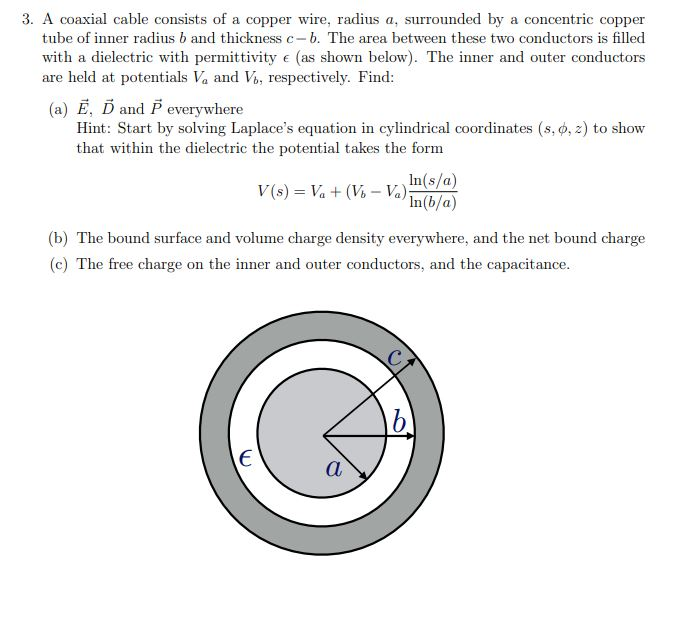Question
3. A coaxial cable consists of a copper wire, radius a, surrounded by a concentric copper tube of inner radius b and thickness c-b.

3. A coaxial cable consists of a copper wire, radius a, surrounded by a concentric copper tube of inner radius b and thickness c-b. The area between these two conductors is filled with a dielectric with permittivity (as shown below). The inner and outer conductors are held at potentials V and V, respectively. Find: (a) , and P everywhere Hint: Start by solving Laplace's equation in cylindrical coordinates (s, o, z) to show that within the dielectric the potential takes the form V(s) = V + (Vb - Va) (b) The bound surface and volume charge density everywhere, and the net bound charge (c) The free charge on the inner and outer conductors, and the capacitance. a In(s/a) In(b/a) C
Step by Step Solution
3.54 Rating (157 Votes )
There are 3 Steps involved in it
Step: 1

Get Instant Access to Expert-Tailored Solutions
See step-by-step solutions with expert insights and AI powered tools for academic success
Step: 2

Step: 3

Ace Your Homework with AI
Get the answers you need in no time with our AI-driven, step-by-step assistance
Get StartedRecommended Textbook for
Introduction to Electrodynamics
Authors: David J. Griffiths
3rd Edition
978-0138053260, 013805326X, 8120316010, 978-8120316010
Students also viewed these Law questions
Question
Answered: 1 week ago
Question
Answered: 1 week ago
Question
Answered: 1 week ago
Question
Answered: 1 week ago
Question
Answered: 1 week ago
Question
Answered: 1 week ago
Question
Answered: 1 week ago
Question
Answered: 1 week ago
Question
Answered: 1 week ago
Question
Answered: 1 week ago
Question
Answered: 1 week ago
Question
Answered: 1 week ago
Question
Answered: 1 week ago
Question
Answered: 1 week ago
Question
Answered: 1 week ago
Question
Answered: 1 week ago
Question
Answered: 1 week ago
Question
Answered: 1 week ago
Question
Answered: 1 week ago
Question
Answered: 1 week ago
Question
Answered: 1 week ago
Question
Answered: 1 week ago
View Answer in SolutionInn App



